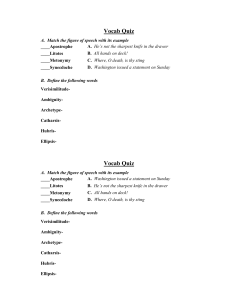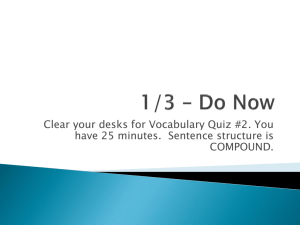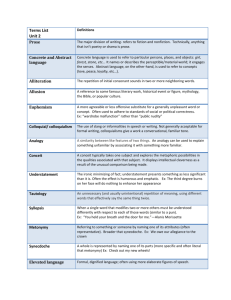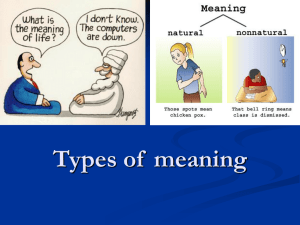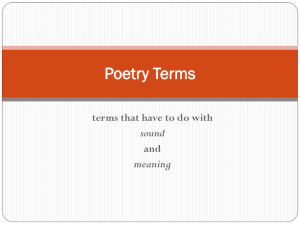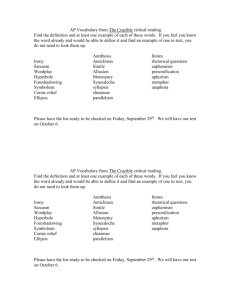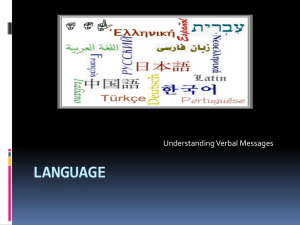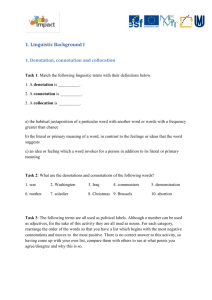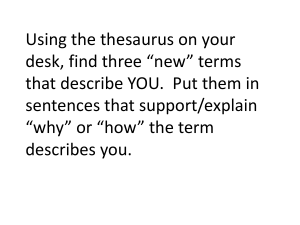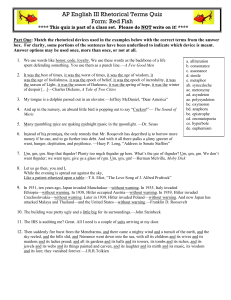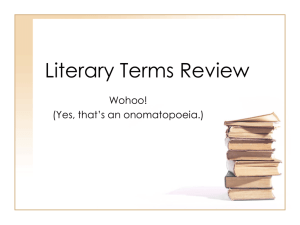Example
advertisement
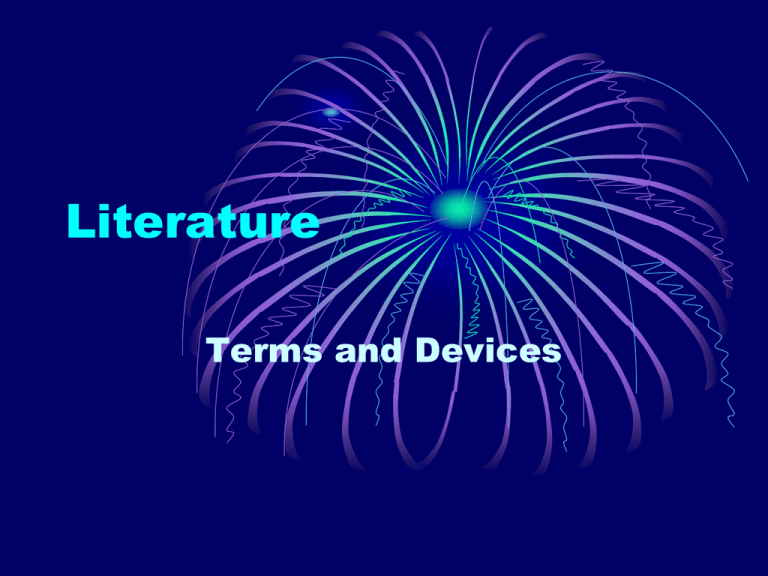
Literature Terms and Devices Literal Language • language used to state a fact or idea directly. • Example: He collapsed on the grass weakly. Meaning Devices • Devices used by authors that directly affect the meaning of the words, phrases, sentences, etc. of a piece of literature. Diction • Diction- Writer’s choice of words • WORD CHOICE • The words that a writer chooses to use may carry both denotative and connotative meanings. Denotative • is its explicit definition as listed in a dictionary. (Dictionary Definition) Connotative • the association or set of associations that a word usually brings to mind (Self/Association Definition) Denotative Vs. Connotative Denotation any of numerous scaly, legless, sometimes venomous reptiles; having a long, tapering, cylindrical body and found in most tropical and temperate regions Connotation Evil, danger, deceit Syntax • Writer’s ordering of words • Word Order • The way that an author orders words can directly affect the meaning • Ex/ Mary loves John does not mean that John loves Mary The dog bit the man. Translates differently than The man bit the dog. Figurative Language • language that represents one thing in terms of another. (animism, apostrophe, hyperbole, metaphor, metonymy, personification, simile, synecdoche, and understatement.) • Example: He collapsed on the grass like a half-empty flour sack. Figure of Speech • statement that is not literally true but makes an abstraction more understandable; an expression in which words are used in a non-literal way in order to convey a forceful or vivid mental picture. Animism • attributing life, but not human life, to an inanimate thing or natural object or to something that is not that animal. Animism Example Fog by: Carl Sandburg “The fog comes on little cat feet. It sits looking over harbor and city on silent haunches and then moves on.” Apostrophe • addressing an abstract quality, an inanimate object, or a person (usually absent). Apostrophe Examples “O world, I cannot hold thee close enough!” --Edna St. Vincent Millay’s “God’s World” “O wild West Wind, thou breath of Autumn’s being”—Shelley “To what purpose, April, do you return again?” --Edna St. Vincent Millay Hyperbole • an obvious overstatement or exaggeration. • Examples: • The students worked their fingers to the bone completing their English assignments. • Before he reached the dentist’s office, he died a thousand deaths. Idiom • language typical of a particular group of people in which words do not directly translate into their literal meaning. • Examples: • turn over a new leaf (begin again) • hold your tongue (be quiet) Metaphor • a statement that says one thing is something else, which literally it is not; a statement that identifies two things with each other. • Examples: • The tumbleweeds are the lost children of the desert. • The ocean is a huge swimming pool. Metonymy • the use of the name of one thing to substitute for something closely associated with it. • Examples: The White House decided…(meaning the President decided) • The pot is boiling… (meaning what is in the pot is boiling) Oxymoron • a very short self-contradictory statement; a compressed paradox. • Examples: Good Grief, Minor Miracle, Small Fortune, Little Big Horn, Old News, Dull Roar, Baby Grand, White Gold Paradox • a statement that seems to be self-contradictory or absurd but really involves an element of truth. Paradox Examples • “The child is the father of the man.” --William Wordsworth • “The peasant lives in a larger world than a globe trotter.” --G.K. Chesterton Personification • giving human qualities to something non-human (an animal or a thing). • Example: “The wind stood up and gave a shout.”-- James Stephens. Simile • a comparison of two different things that is introduced by like or as. • Examples: • The moon shone like a new silver dollar. • “O, my love is like a red, red rose.”— Robert Burns Synecdoche • a special kind of metonymy that uses part of a thing to stand for the whole thing. This part must be an essential element of the whole and directly descriptive of it. Synecdoche Example • Examples: • Forty heads of cattle were missing • All hands on deck. Understatement • A technique of creating emphasis by saying less than what is actually true. • Example: from Tony Hillerman’s The Great Taos Bank Robbery ~ “The reader might well pause here and recollect that it is traditional for robbers to steal escape vehicles, not to borrow them from friends.” Literary Devices that depend on the sounds that words make: • alliteration, assonance, consonance, onomatopoeia, rhyme, and rhythm. Alliteration • repetition of the same consonant sound used in two or more words that occur close together. • Example: The little lady loved to listen to lullabies. Assonance • repetition of the same vowel sounds in words where the consonants are different. • Example: fate and sake; ivory eyes; beach and seem Consonance • repetition of the same consonant sound especially at the end of a stressed syllables. • Examples: The first and last toast; Crisscross; Chitter chatter Onomatopoeia • a word or phrase that imitates the sound of what it describes. • Example: buzz, hiss, crash, whirr, clash, hoot Other Devices Allusion • Reference to a person, place, event, or thing with literary, historical, or geographical significance • Examples: In the novel To Kill a Mockingbird, Harper Lee includes an allusion to Franklin D. Roosevelt’s inaugural address. (“We have nothing to fear but fear itself.”) Cliché • a phrase or expression that has been used so much that it has lost its novelty and interest. • Example: She avoided me like the plague. Imagery • words used to create a sensory (hearing, taste, smell, touch, or sight) experience. • Example: The puppy’s cold nose nudged my hand.
